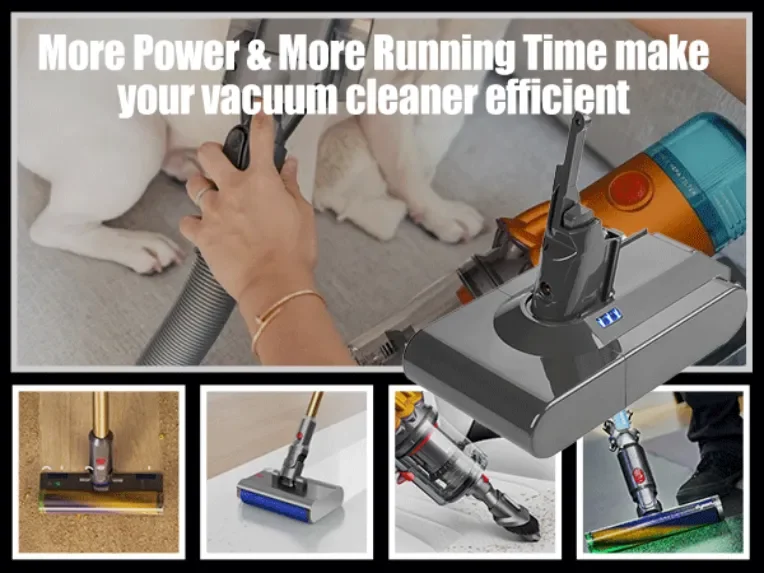Vacuum Cleaner Battery Troubleshooting Guide
A weak battery for vacuum cleaner can reduce a cordless vacuum to little more than a handheld duster by causing rapid power loss, unexpected shut-offs or runtimes far below specs. This blog shows how to diagnose real causes—aging Li-Ion cells after 300–500 cycles, clogged filters, incorrect chargers or extreme temperatures—using simple tests and preventive cleaning. It explains how to select the best battery for vacuum cleaner by comparing chemistries (Li-Ion, NiMH, NiCd), matching voltage, capacity, BMS protection, form factor and cost per watt-hour. You’ll learn charging practices—avoiding deep discharges, using slow-charge modes and storing at 40–60% state of charge—as well as routine maintenance like quarterly rebalance cycles and monthly contact cleaning to extend lifespan. Finally, safety advice covers preventing over-charge and over-discharge, managing operating/storage temperatures, and isolating or recycling swollen or leaking packs.

1. Introduction
A weak or failing battery for vacuum cleaner can turn your once-powerful cordless vacuum into little more than a handheld dust collector. Common frustrations include:
- “Why does my vacuum lose power so fast?”
- “Which replacement battery actually fits my model?”
This guide will help you.
1. Diagnose the real causes of sudden suction loss or unexpected shut-offs
2. Select the best battery for vacuum cleaner—from chemistry and capacity to cost and compatibility
3. Extend battery lifespan through practical maintenance and safe usage
2. Why Does My Vacuum Lose Suction or Shut Off Early?
2.1 Common Symptoms
- Noticeable drop in suction mid-clean
- Vacuum powers off unexpectedly before rated runtime
- Measured runtime far below manufacturer’s spec
2.2 In-Depth Causes & Solutions
| Cause Category | Industry Insight | Solution |
| Battery Degradation | After 300–500 full cycles, Li-Ion packs typically drop to 70%–80% capacity. Over 80% of users replace after 18 months | Test with a multimeter: a healthy 18 V pack reads ≥ 19.5 V; if < 18 V, replace or have cells serviced |
| Clogged Filters | Blockages increase motor load by 30%–50%, accelerating drain on your battery for vacuum cleaner | Clean or replace filters weekly; remove hair from brush roll; lubricate bearings per manual |
| Incorrect Charger | Non-OEM chargers deliver 70%–90% efficiency and risk overcharging | Use manufacturer or certified Li-Ion charger (18 V/21.6 V); avoid extended fast-charge modes |
| Extreme Temperatures | Performance can drop by 20% below 5 °C or above 40 °C | Keep charging environment between 10 °C–30 °C; allow battery to cool before charging if overheated |
3. How Do I Choose the Right Vacuum Battery?
> Market Insight: In 2024, Li-Ion batteries accounted for 88% of the home cleaning tools market; NiMH and NiCd are niche.
3.1 Chemistry Comparison
| Chemistry Type | Pros | Cons | Ideal Use Cases |
| Li-Ion | High energy density (150 Wh/kg), lightweight, low self-discharge | Higher cost; narrower temperature range | Heavy daily use, pet hair, long sessions |
| NiMH | Mid-range cost; no “memory effect” | 20%–30% monthly self-discharge; lower density | Occasional cleaning, budget-minded |
| NiCd | Stable in extreme temperatures; high discharge rates | Toxic cadmium; memory effect; lowest density | Cold climates, certain industrial use |
3.2 Key Selection Criteria
| Criterion | Recommendation |
| Voltage Compatibility | Match your vacuum’s rating (e.g., 18 V vs. 21.6 V) |
| Capacity (mAh/Ah) | 2 000–4 000 mAh for average use; 5 000 mAh+ for extended sessions |
| Built-in BMS | Ensure over-charge, over-discharge, short-circuit, and thermal protections |
| Size & Connector | Slide-on” footprint and latch must align perfectly for reliable contact |
| Value ($/Wh) | Aim for \$0.20–\$0.30 per Wh; premium brands up to \$0.40/Wh |
4. How Can I Extend My Vacuum Battery’s Lifespan?
4.1 Best Charging Practices
- Avoid draining below 20%—deep discharge stresses Li-Ion cells
- Use slow-charge mode (0.1 C) overnight to boost cycle life by 10%–15%
- Unplug within 1 hour of full charge to minimize trickle-charge stress
4.2 Storage & Routine Maintenance
| Interval | Maintenance Steps |
| > 2 months idle | Store at 40%–60% state of charge; top up to ~50% every 2–3 months to prevent BMS lockout |
| Quarterly | Run a full cycle (100% → empty) to rebalance cells |
| Monthly | Clean battery contacts and casing with 70% isopropyl alcohol; inspect for corrosion or cracks |
5. Safety Precautions
5.1 Prevent Over-Charge & Over-Discharge
- Warning signs: Swollen pack, rapid LED flashing, inability to hold charge
- Best practice: Never exceed manufacturer’s recommended charge time; store at ~40% if unused long-term
5.2 Temperature Management
- Operating: 5 °C–40 °C
- Storage: 10 °C–25 °C to minimize self-discharge and thermal stress
5.3 Handling Faulty Batteries
- Swelling or leakage: Disconnect immediately; isolate in a fire-resistant container and recycle.
- Physical damage: Do not charge; send to certified hazardous-waste center.
6. Tools & Resources
- Multimeter Tutorial:
- Battery Health Apps:
- Battery HD (iOS)
- Ampere (Android)
- Recycling & Disposal:
- Call2Recycle (call2recycle.org)
- Local hazardous-waste facilities
7. Conclusion & Next Steps
You now know how to:
1. Identify why your vacuum loses suction or shuts off
2. Select the right battery for vacuum cleaner based on chemistry and specs
3. Implement maintenance strategies that prolong service life
4. Follow safety guidelines to avoid accidents
FAQ
1. Can I use a higher-capacity battery for vacuum cleaner?
Yes—provided voltage and connector match. Higher mAh extends runtime but adds weight.
2. My new battery still drains quickly—why?
Check filters, brush roll, and charger compatibility. Mechanical or circuit issues often mimic battery faults.
3. Are third-party batteries safe?
When they include UL/CE certification, a proper BMS, and match original form factor, they’re a reliable choice.